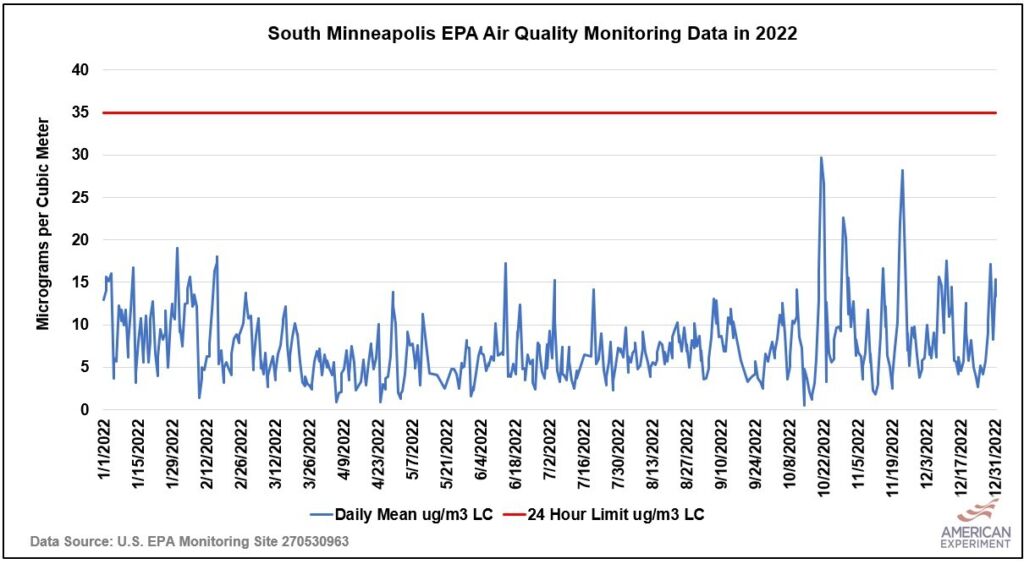Minneapolis bans new industrial facilities and the good-paying jobs that come with them in the name of “environmental justice”
On May 25, 2023, the Minneapolis City Council unanimously voted to ban new heavy industries and limit the expansion of existing facilities in the city via an update to city zoning codes due to the city’s concerns about the environment.
Newly-banned industries include new scrap metal industries, chemical manufacturers, commercial laundries, combustion-powered energy facilities, and foundries, according to a report by the Sahan Journal.
Unfortunately, this means Minneapolis will also be banning the jobs and economic opportunities that come with these industries despite the fact that air monitoring data from the U.S. Environmental Protection Agency (EPA) shows the air quality in Minneapolis is good, and pollution levels are far below levels that EPA considers hazardous.
As a result, the loss of this economic opportunity will hurt the low-income communities the city council members think they are protecting with the ordinance.
Smith Foundry tour
On Wednesday, May 31, I was invited to visit the Smith Foundry, one of the existing facilities that would not be allowed to expand under the new zoning rules.
This foundry has been located in south Minneapolis since 1923, where it manufactured iron castings for pot belly stoves used in one-room schoolhouses and town halls. Today, the foundry produces metal parts for over 300 customers, including water purification companies and tractor-building companies.
The company employs 65 people. Approximately 53 of them are full-time union employees, and 12 are temporary employees hired on an attempt-to-hire basis. After 60 days, temporary employees can become part of the Teamsters Union. Many of the employees I saw on my visit were from diverse backgrounds.
Starting salaries at the foundry start at $18.50 per hour and go up to $21 per hour, and employees have excellent health insurance benefits under the Teamsters. Employees work 10-hour days, and with overtime, they can earn between $60,000 and $70,000 per year.
The Smith Foundry is also a Second Chance Employer, meaning they hire people with criminal records if they are willing to work.
While foundry workers live throughout the Minneapolis area, many of them live in the neighborhood where the foundry is located, and many of these workers walk to work each day.
Isn’t this exactly the kind of employer that the members of the City Council say they want for the future of the city?
Living in fantasy land
According to the Star Tribune, the city council appears to understand that these facilities create jobs, but not the kind the city wants:
“The analysis noted that manufacturing districts create jobs and recommended that the city reserve industrial land for facilities that produce minimal pollution impacts and pay a living wage, which are less likely to face community opposition.”
The problem with this idea is that it won’t happen in reality.
The city has wanted to repurpose the old “Roof Depot” site, on which it has spent $16.7 million, and build a new water yard there to expand its public works campus in the neighborhood. However, the same groups who applauded the city council’s vote banning new industrial facilities opposed the expansion of the City’s waterworks facilities.
Instead, these groups have proposed an eight-acre urban farm in the area. The urban farm would use aquaponics to grow fish and plants in a system that doesn’t need soil. The Bureau of Labor Statistics does not have wage data for urban farmers in Minneapolis, but it is doubtful that the urban farm will generate $3.9 million in wages as the Smith Foundry does.
A solution in search of a problem
While members of the city council voted to ban new industrial facilities or allow existing facilities to expand based on environmental grounds, real-life air monitoring data from EPA show the ordinance was completely unjustified.
For example, EPA data from the Anderson School air monitoring station, an air monitoring station less than a mile away from the Smith Foundry, show zero days in 2022 where levels of particulate matter measuring 2.5 microns in diameter, known as PM2.5, exceeded EPA’s 24-hour limit of 35 micrograms per cubic meter (ug/m3) on these particles.

Additionally, the annual average concentration of PM2.5 at this monitoring station was 7.5 ug/m3, which is far better than the EPA’s current standard of 12 ug/m3, and it is even better than the proposed revision of EPA’s standard to 9 ug/m3.
EPA establishes air quality standards designed to protect public health, even of vulnerable populations, with an adequate margin of safety. This means there is no scientific basis for the city council’s claims that air quality in the area is bad and that these new zoning regulations are justified.
Furthermore, data from the Minnesota Pollution Control Agency show that Minnesota’s air quality meets all of the federal standards for criteria pollutants, and days of lower air quality were caused by wildfire smoke being transported to Minnesota, not the industrial facilities Minneapolis is regulating out of business.
In closing, the City of Minneapolis is making a huge mistake by banning new industrial facilities and prohibiting existing facilities from expanding within city limits. Doing so will harm low-income neighborhoods by preventing new job opportunities from coming to an area, and the rules will not meaningfully improve air quality because it already meets the EPA’s standards.